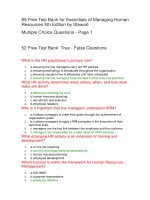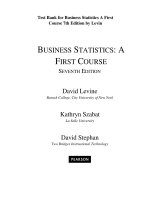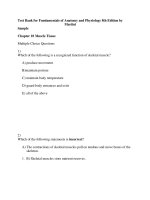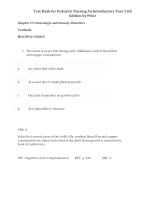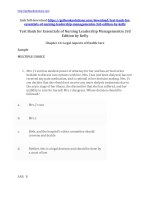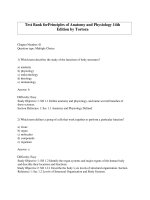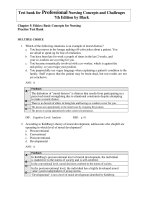download test bank for principles of managerial finance brief 7th edition by gitman
Bạn đang xem bản rút gọn của tài liệu. Xem và tải ngay bản đầy đủ của tài liệu tại đây (314.23 KB, 32 trang )
Principles of Managerial Finance, Brief, 7e (Gitman)
Chapter 2 The Financial Market Environment
2.1 Understand the role that financial institutions play in managerial finance.
1) A financial institution is an intermediary that channels the savings of individuals, businesses,
and governments into loans or investments.
Answer: TRUE
Diff: 1
Topic: Financial Institutions
Learning Obj.: LG 1
Learning Outcome: F-01
Question Status: Previous Edition
AACSB Tag: Analytic Skills
2) Commercial banks advise firms on major transactions such as mergers or financial
restructurings.
Answer: FALSE
Diff: 1
Topic: Financial Institutions
Learning Obj.: LG 1
Learning Outcome: F-01
Question Status: Previous Edition
AACSB Tag: Analytic Skills
3) As a key participant in financial transactions, individuals are
.
A) net demanders of funds because they save more money than they borrow
B) net users of funds because they save less money than they borrow
C) net suppliers of funds because they save more money than they borrow
D) net purchasers of funds because they save more money than they borrow
Answer: C
Diff: 1
Topic: Financial Institutions
Learning Obj.: LG 1
Learning Outcome: F-01
Question Status: New
AACSB Tag: Analytic Skills
1
Copyright © 2015 Pearson Education, Inc.
4) Government is typically a
.
A) net provider of funds because it borrows more than it saves
B) net demander of funds because it borrows more than it saves
C) net provider of funds because it can print money at will
D) net demander of funds because it saves more than it borrows
Answer: B
Diff: 1
Topic: Financial Institutions
Learning Obj.: LG 1
Learning Outcome: F-01
Question Status: New
AACSB Tag: Analytic Skills
5) Government can obtain funds
.
A) by trading in equity market
B) by issuing financial instruments such as futures and options
C) through forex market
D) by selling debt securities
Answer: D
Diff: 1
Topic: Financial Institutions
Learning Obj.: LG 1
Learning Outcome: F-01
Question Status: Revised
AACSB Tag: Analytic Skills
6) Firms that require funds from external sources can obtain them
A) through financial institutions
B) from central bank directly
C) through forex market
D) by issuing T-bills
Answer: A
Diff: 1
Topic: Financial Institutions
Learning Obj.: LG 1
Learning Outcome: F-01
Question Status: Revised
AACSB Tag: Analytic Skills
2
Copyright © 2015 Pearson Education, Inc.
_.
7) Investment banks are institutions that
.
A) perform all activities of commercial banks and retail banks
B) are exempted from Securities and Exchange Commission regulations
C) engage in trading and market making activities
D) are only limited to capital market activities
Answer: C
Diff: 1
Topic: Commercial Banks, Investment Banks, And The Shadow Banking System
Learning Obj.: LG 1
Learning Outcome: F-01
Question Status: Revised
AACSB Tag: Analytic Skills
8) Which of the following serves as an intermediary channeling the savings of individuals,
businesses, and governments into loans and investments?
A) financial institutions
B) financial markets
C) Securities and Exchange Commission
D) OTC market
Answer: A
Diff: 1
Topic: Financial Institutions
Learning Obj.: LG 1
Learning Outcome: F-01
Question Status: Revised
AACSB Tag: Analytic Skills
9) The shadow banking system describes a group of institutions that engage in lending activities,
much like traditional banks.
Answer: TRUE
Diff: 1
Topic: Commercial Banks, Investment Banks, And The Shadow Banking System
Learning Obj.: LG 1
Learning Outcome: F-01
Question Status: Previous Edition
AACSB Tag: Analytic Skills
3
Copyright © 2015 Pearson Education, Inc.
10) Which of the following provides savers with a secure place to invest funds and offer both
individuals and companies loans to finance investments?
A) investment banks
B) securities exchanges
C) mutual funds
D) commercial banks
Answer: D
Diff: 1
Topic: Commercial Banks, Investment Banks, And The Shadow Banking System
Learning Obj.: LG 1
Learning Outcome: F-01
Question Status: Revised
AACSB Tag: Analytic Skills
11) Which of the following assists companies in raising capital, advise firms on major
transactions such as mergers or financial restructuring, and engage in trading and market making
activities?
A) investment banks
B) securities exchanges
C) mutual funds
D) commercial banks
Answer: A
Diff: 1
Topic: Commercial Banks, Investment Banks, And The Shadow Banking System
Learning Obj.: LG 1
Learning Outcome: F-01
Question Status: Revised
AACSB Tag: Analytic Skills
4
Copyright © 2015 Pearson Education, Inc.
2.2 Contrast the functions of financial institutions and financial markets.
1) Primary and secondary markets are markets for short-term and long-term securities,
respectively.
Answer: FALSE
Diff: 1
Topic: Financial Markets
Learning Obj.: LG 2
Learning Outcome: F-01
Question Status: Previous Edition
AACSB Tag: Analytic Skills
2) Financial markets are intermediaries that channel the savings of individuals, businesses, and
government into loans or investments.
Answer: FALSE
Diff: 1
Topic: Financial Markets
Learning Obj.: LG 2
Learning Outcome: F-01
Question Status: Previous Edition
AACSB Tag: Analytic Skills
3) A public offering is the sale of a new security issue—typically debt or preferred stock—
directly to an investor or group of investors.
Answer: FALSE
Diff: 1
Topic: Financial Markets
Learning Obj.: LG 2
Learning Outcome: F-01
Question Status: Previous Edition
AACSB Tag: Analytic Skills
4) A primary market is a financial market in which pre-owned securities are traded.
Answer: FALSE
Diff: 1
Topic: Financial Markets
Learning Obj.: LG 2
Learning Outcome: F-01
Question Status: Previous Edition
AACSB Tag: Analytic Skills
5
Copyright © 2015 Pearson Education, Inc.
5) The Glass-Steagall Act was imposed to allow commercial and investment banks to combine
and work together.
Answer: FALSE
Diff: 1
Topic: Financial Institutions and Markets
Learning Obj.: LG 2
Learning Outcome: F-01
Question Status: Previous Edition
AACSB Tag: Analytic Skills
6) Most businesses raise money by selling their securities in a
A) public offering
B) forex market
C) futures market
D) commodities market
Answer: A
Diff: 1
Topic: Financial Markets
Learning Obj.: LG 2
Learning Outcome: F-01
Question Status: Revised
AACSB Tag: Analytic Skills
.
7) Which of the following is a means of selling bonds or stocks to the public?
A) private placement
B) public offering
C) organized selling
D) direct placement
Answer: B
Diff: 1
Topic: Financial Markets
Learning Obj.: LG 2
Learning Outcome: F-01
Question Status: Revised
AACSB Tag: Analytic Skills
6
Copyright © 2015 Pearson Education, Inc.
8) Which of the following is a forum in which suppliers and demanders of funds can transact
business directly?
A) shadow banking system
B) financial markets
C) commercial banks
D) financial institutions
Answer: B
Diff: 1
Topic: Financial Markets
Learning Obj.: LG 2
Learning Outcome: F-01
Question Status: Revised
AACSB Tag: Analytic Skills
9) The sale of a new security directly to an investor or a group of investors is called
A) arbitraging
B) short selling
C) a capital market transaction
D) a private placement
Answer: D
Diff: 1
Topic: Financial Markets
Learning Obj.: LG 2
Learning Outcome: F-01
Question Status: Revised
AACSB Tag: Analytic Skills
10) The
market is where securities are initially issued and the
where pre-owned securities (not new issues) are traded.
A) primary; secondary
B) money; capital
C) secondary; primary
D) primary; money
Answer: A
Diff: 1
Topic: Financial Markets
Learning Obj.: LG 2
Learning Outcome: F-01
Question Status: Previous Edition
AACSB Tag: Analytic Skills
7
Copyright © 2015 Pearson Education, Inc.
market is
.
2.3 Describe the differences between the capital markets and the money markets.
1) The over-the-counter (OTC) market is a market for trading smaller and unlisted securities.
Answer: TRUE
Diff: 1
Topic: Financial Markets
Learning Obj.: LG 3
Learning Outcome: F-01
Question Status: Revised
AACSB Tag: Analytic Skills
2) NASDAQ is considered an OTC market since it is not recognized by the SEC as a "listed
exchange."
Answer: FALSE
Diff: 1
Topic: Financial Markets
Learning Obj.: LG 3
Learning Outcome: F-01
Question Status: Previous Edition
AACSB Tag: Analytic Skills
3) In the OTC market, the ask price is the highest price offered by a dealer to purchase a given
security.
Answer: FALSE
Diff: 1
Topic: Financial Markets
Learning Obj.: LG 3
Learning Outcome: F-01
Question Status: Previous Edition
AACSB Tag: Analytic Skills
4) In the Eurobond market, corporations and governments typically issue bonds denominated in
dollars and sell them to investors located outside the United States.
Answer: TRUE
Diff: 1
Topic: Financial Markets
Learning Obj.: LG 3
Learning Outcome: F-01
Question Status: Previous Edition
AACSB Tag: Analytic Skills
8
Copyright © 2015 Pearson Education, Inc.
5) Capital markets are for investors who want a safe temporary place to deposit funds where they
can earn interest and for borrowers who have a short-term need for funds.
Answer: FALSE
Diff: 1
Topic: Financial Markets
Learning Obj.: LG 3
Learning Outcome: F-01
Question Status: Previous Edition
AACSB Tag: Analytic Skills
6) Money markets are markets for long-term funds such as bonds and equity.
Answer: FALSE
Diff: 1
Topic: Financial Markets
Learning Obj.: LG 3
Learning Outcome: F-01
Question Status: Revised
AACSB Tag: Analytic Skills
7) An efficient market is a market that establishes correct prices for the securities that firms sell
and allocates funds to their most productive use as a result of the intense competition among
investors.
Answer: TRUE
Diff: 1
Topic: Financial Markets
Learning Obj.: LG 3
Learning Outcome: F-01
Question Status: Revised
AACSB Tag: Analytic Skills
8) Money markets involve the trading of securities with maturities of one year or less.
Answer: TRUE
Diff: 1
Topic: Financial Markets
Learning Obj.: LG 3
Learning Outcome: F-01
Question Status: Revised
AACSB Tag: Analytic Skills
9
Copyright © 2015 Pearson Education, Inc.
9) Eurocurrency deposits arise when a corporation or individual makes a deposit in a bank in a
currency other than the local currency of the country where the bank is located.
Answer: TRUE
Diff: 1
Topic: Financial Markets
Learning Obj.: LG 3
Learning Outcome: F-01
Question Status: Previous Edition
AACSB Tag: Analytic Skills
10) The Eurocurrency market is a market for short-term bank deposits denominated in U.S.
dollars or other easily convertible currencies.
Answer: TRUE
Diff: 1
Topic: Financial Markets
Learning Obj.: LG 3
Learning Outcome: F-01
Question Status: Previous Edition
AACSB Tag: Analytic Skills
11) The money market is a financial relationship created by a number of institutions and
arrangements that allows suppliers and demanders of long-term funds to make transactions.
Answer: FALSE
Diff: 1
Topic: Financial Markets
Learning Obj.: LG 3
Learning Outcome: F-01
Question Status: Previous Edition
AACSB Tag: Analytic Skills
12) The over-the-counter (OTC) market is
.
A) a highly liquid market as compared to NASDAQ
B) a market in which low risk-high return securities are traded
C) an organized market in which all financial derivatives are traded
D) a market where smaller, unlisted securities are traded
Answer: D
Diff: 1
Topic: Financial Markets
Learning Obj.: LG 3
Learning Outcome: F-01
Question Status: Revised
AACSB Tag: Analytic Skills
10
Copyright © 2015 Pearson Education, Inc.
13) Which of the following is true of a primary market?
A) It is an organized market in which all financial derivatives are traded.
B) It is regulated by The Sarbanes-Oxley Act.
C) It is a market where smaller, unlisted securities are traded.
D) It is the only market in which the issuer is directly involved in the transaction.
Answer: D
Diff: 1
Topic: Financial Markets
Learning Obj.: LG 3
Learning Outcome: F-01
Question Status: New
AACSB Tag: Analytic Skills
14) Which of the following is true of a secondary market?
A) It is a market for an unlisted company to raise equity capital.
B) It is a market where securities are issued through private placement
C) It is a market in which short-term money market instruments such as Treasury bills are traded.
D) It is a market in which preowned securities are traded.
Answer: D
Diff: 1
Topic: Financial Markets
Learning Obj.: LG 3
Learning Outcome: F-01
Question Status: New
AACSB Tag: Analytic Skills
15) Which of the following is true of preferred stock?
A) It has features of bonds and a common stock.
B) It has a claim on assets prior to creditors in the event of liquidation.
C) Its dividends can be paid only after paying dividends to the common stockholders.
D) It usually has a maturity of thirty years.
Answer: A
Diff: 2
Topic: Financial Markets
Learning Obj.: LG 3
Learning Outcome: F-01
Question Status: New
AACSB Tag: Analytic Skills
11
Copyright © 2015 Pearson Education, Inc.
16) The key securities traded in the capital markets are
A) commercial papers and Treasury bills
B) Treasury bills and certificates of deposit
C) stocks and bonds
D) bills of exchange and commercial papers
Answer: C
Diff: 1
Topic: Financial Markets
Learning Obj.: LG 3
Learning Outcome: F-01
Question Status: Revised
AACSB Tag: Analytic Skills
.
17) Which of the following is true of international equity markets?
A) In the international equity market, corporations cannot raise capital through IPOs, instead
they can raise capital by trading in the secondary market.
B) In the international equity market, corporations can easily manipulate the price of the shares
since it is not regulated by any regulatory bodies.
C) In the international equity market, corporations can only sell blocks of shares to institutional
investors from European Union.
D) In the international equity market, corporations can sell blocks of shares to investors in a
number of different countries simultaneously.
Answer: D
Diff: 1
Topic: Financial Markets
Learning Obj.: LG 3
Learning Outcome: F-01
Question Status: New
AACSB Tag: Analytic Skills
18) Which of the following is true of a dealer market?
A) Buyers and sellers are never brought together directly.
B) Brokers execute the buy or sell orders in a dealer market.
C) It has centralized trading floors.
D) It is a part of the broker market.
Answer: A
Diff: 2
Topic: Financial Markets
Learning Obj.: LG 3
Learning Outcome: F-01
Question Status: New
AACSB Tag: Analytic Skills
12
Copyright © 2015 Pearson Education, Inc.
19) Which of the following is true of a securities exchange?
A) It serves as an intermediary by channeling the savings of individuals, businesses, and
governments into loans or investments.
B) It borrows funds directly from the financial institutions.
C) It is an association of banks who meet to buy and sell stocks and bonds.
D) It provides a marketplace in which firms can raise funds through the sale of new securities
and purchasers can resell securities.
Answer: D
Diff: 2
Topic: Financial Markets
Learning Obj.: LG 3
Learning Outcome: F-01
Question Status: New
AACSB Tag: Analytic Skills
20) A market that establishes correct prices for the securities that firms sell and allocates funds to
their most productive uses is called a(n)
.
A) future market
B) forex market
C) efficient market
D) weak-form market
Answer: C
Diff: 1
Topic: Financial Markets
Learning Obj.: LG 3
Learning Outcome: F-01
Question Status: Revised
AACSB Tag: Analytic Skills
21) The
is created by a financial relationship between suppliers and demanders of
short-term funds.
A) stock market
B) capital market
C) forex market
D) money market
Answer: D
Diff: 1
Topic: Financial Markets
Learning Obj.: LG 3
Learning Outcome: F-01
Question Status: Previous Edition
AACSB Tag: Analytic Skills
13
Copyright © 2015 Pearson Education, Inc.
22) By definition, the money market involves the buying and selling of
A) stocks and bonds
B) short-term securities
C) all financial instruments except derivatives
D) secured premium notes
Answer: B
Diff: 1
Topic: Financial Markets
Learning Obj.: LG 3
Learning Outcome: F-01
Question Status: Revised
AACSB Tag: Analytic Skills
23) Most money market transactions are made in
A) common stock
B) marketable securities
C) commodities market
D) preferred stock
Answer: B
Diff: 1
Topic: Financial Markets
Learning Obj.: LG 3
Learning Outcome: F-01
Question Status: Revised
AACSB Tag: Analytic Skills
.
.
24) The
is created by a number of institutions and arrangements that allow the
suppliers and demanders of long-term funds to make transactions.
A) forex market
B) capital market
C) money market
D) commodities market
Answer: B
Diff: 1
Topic: Financial Markets
Learning Obj.: LG 3
Learning Outcome: F-01
Question Status: Previous Edition
AACSB Tag: Analytic Skills
14
Copyright © 2015 Pearson Education, Inc.
25) Long-term debt instruments used by both government and business are known as
A) preferred stocks
B) T-bills
C) bonds
D) equities
Answer: C
Diff: 1
Topic: Financial Markets
Learning Obj.: LG 3
Learning Outcome: F-01
Question Status: Revised
AACSB Tag: Analytic Skills
26) Which of the following is an example of marketable securities?
A) U.S.Treasury bills
B) treasury stock
C) mortgage backed securities
D) loans
Answer: A
Diff: 1
Topic: Financial Markets
Learning Obj.: LG 3
Learning Outcome: F-01
Question Status: Revised
AACSB Tag: Analytic Skills
27) In a
market, the buyer and seller are brought together to trade securities in an
organization called
.
A) dealer; securities market
B) broker; over-the -counter market
C) broker; securities market
D) dealer; over-the-counter market
Answer: C
Diff: 1
Topic: Financial Markets
Learning Obj.: LG 3
Learning Outcome: F-01
Question Status: Previous Edition
AACSB Tag: Analytic Skills
15
Copyright © 2015 Pearson Education, Inc.
.
28) In a
market, the buyer and seller are not brought together to trade securities
directly but instead have their orders executed on the
.
A) dealer; securities market
B) broker; over-the -counter market
C) broker; securities market
D) dealer; over-the-counter market
Answer: D
Diff: 1
Topic: Financial Markets
Learning Obj.: LG 3
Learning Outcome: F-01
Question Status: Previous Edition
AACSB Tag: Analytic Skills
29) An efficient market is one where
.
A) prices of stocks move up and down widely without apparent reason
B) prices of stocks remain low for long periods of time
C) prices of stocks are unaffected by market news
D) the price of a security is an unbiased estimate of its true value
Answer: D
Diff: 1
Topic: The Capital Market
Learning Obj.: LG 3
Learning Outcome: F-01
Question Status: Revised
AACSB Tag: Analytic Skills
30) The money market is a market
.
A) that enables suppliers and demanders of long-term funds to make transactions
B) which brings together suppliers and demanders of short-term funds
C) where smaller, unlisted securities are traded
D) where all derivatives are traded
Answer: B
Diff: 2
Topic: The Capital Market
Learning Obj.: LG 3
Learning Outcome: F-01
Question Status: New
AACSB Tag: Analytic Skills
16
Copyright © 2015 Pearson Education, Inc.
31) Apex Inc. issues a bond of $1,000 which pays interest semiannually at a coupon interest rate
of 8%. The maturity of the bond is 15 years. Where should this bond be traded?
A) forex market
B) money market
C) capital market
D) commodities market
Answer: C
Diff: 2
Topic: The Capital Market
Learning Obj.: LG 3
Learning Outcome: F-01
Question Status: New
AACSB Tag: Reflective Thinking Skills
2.4 Explain the root causes of the 2008 financial crisis and recession.
1) Securitization is the process of pooling mortgages or other types of loans and selling the
claims or securities against that pool in the secondary market.
Answer: TRUE
Diff: 1
Topic: Financial Institutions and Real Estate Finance
Learning Obj.: LG 4
Learning Outcome: F-01
Question Status: Previous Edition
AACSB Tag: Analytic Skills
2) Securitization made it harder for banks to lend money because they could not pass the risk on
to other investors.
Answer: FALSE
Diff: 1
Topic: Financial Institutions and Real Estate Finance
Learning Obj.: LG 4
Learning Outcome: F-01
Question Status: Previous Edition
AACSB Tag: Analytic Skills
3) Mortgage-backed securities are securities that represent claims on the cash flows generated by
a pool of mortgages.
Answer: TRUE
Diff: 1
Topic: Financial Institutions and Real Estate Finance
Learning Obj.: LG 4
Learning Outcome: F-01
Question Status: Previous Edition
AACSB Tag: Analytic Skills
17
Copyright © 2015 Pearson Education, Inc.
4) Prior to the 2008 financial crisis, most investors viewed mortgage-backed securities as
relatively safe investments.
Answer: TRUE
Diff: 1
Topic: Falling Home Prices And Delinquent Mortgages
Learning Obj.: LG 4
Learning Outcome: F-01
Question Status: Previous Edition
AACSB Tag: Analytic Skills
5) Subprime mortgages are mortgage loans made to borrowers with high incomes and better than
average credit histories.
Answer: FALSE
Diff: 1
Topic: Falling Home Prices And Delinquent Mortgages
Learning Obj.: LG 4
Learning Outcome: F-01
Question Status: Previous Edition
AACSB Tag: Analytic Skills
6) Recessions associated with a banking crisis tend to be more severe than other recessions
because many businesses rely on credit to operate.
Answer: TRUE
Diff: 1
Topic: Spillover Effects And The Great Recession
Learning Obj.: LG 4
Learning Outcome: F-01
Question Status: New
AACSB Tag: Analytic Skills
7) The process of pooling mortgages or other types of loans and selling the claims or securities
against that pool in the secondary market is called
.
A) valuation
B) securitization
C) private placement
D) capital restructuring
Answer: B
Diff: 1
Topic: Financial Institutions and Real Estate Finance
Learning Obj.: LG 4
Learning Outcome: F-01
Question Status: Revised
AACSB Tag: Analytic Skills
18
Copyright © 2015 Pearson Education, Inc.
8) The primary risk of mortgage-backed securities is
.
A) that the prices of have high volatility
B) that the prices of housing will increase
C) that the government will not be able to meet the guarantees on the cash flows
D) that homeowners may not be able to, or choose not to, repay their loans
Answer: D
Diff: 2
Topic: Financial Institutions and Real Estate Finance
Learning Obj.: LG 4
Learning Outcome: F-01
Question Status: Revised
AACSB Tag: Analytic Skills
9) Which of the following is true of mortgage-backed securities?
A) Mortgage-backed securities assure a flat 15% return.
B) Mortgage-backed securities are guaranteed by the U.S. government.
C) Mortgage-backed securities can only be purchased by investment banks.
D) Mortgage-backed securities represent claims on the cash flows generated by a pool of
homeloans.
Answer: D
Diff: 2
Topic: Financial Institutions and Real Estate Finance
Learning Obj.: LG 4
Learning Outcome: F-01
Question Status: Revised
AACSB Tag: Analytic Skills
10) When home prices are falling, we would expect a(n)
A) high mortgage default rates
B) low mortgage default rates
C) unchanged mortgage default rates
D) higher percentage of owner home equity
Answer: A
Diff: 2
Topic: Falling Home Prices And Delinquent Mortgages
Learning Obj.: LG 4
Learning Outcome: F-01
Question Status: Revised
AACSB Tag: Reflective Thinking Skills
19
Copyright © 2015 Pearson Education, Inc.
.
11) A crisis in the financial sector often spills over into other industries because when financial
institutions
borrowing, activity in most other industries
.
A) increase; slows down
B) contract; slows down
C) increase; increases
D) contract; increases
Answer: B
Diff: 1
Topic: Spillover Effects And The Great Recession
Learning Obj.: LG 4
Learning Outcome: F-01
Question Status: Previous Edition
AACSB Tag: Analytic Skills
2.5 Understand the major regulations and regulatory bodies that affect financial institutions and
markets.
1) The Glass-Steagall Act
.
A) was intended to regulate the activities in the secondary market
B) created the Securities Exchange Commission
C) separated the activities of commercial and investment banks
D) was intended to regulate the activities in the primary market
Answer: C
Diff: 2
Topic: Regulations Governing Financial Institutions
Learning Obj.: LG 5
Learning Outcome: F-01
Question Status: Revised
AACSB Tag: Analytic Skills
2) The Securities Act of 1933 focuses on regulating the sale of securities in the primary market,
whereas the 1934 Act deals with the regulations governing the transactions in the secondary
market.
Answer: TRUE
Diff: 1
Topic: Regulations Governing Financial Markets
Learning Obj.: LG 5
Learning Outcome: F-01
Question Status: Previous Edition
AACSB Tag: Analytic Skills
20
Copyright © 2015 Pearson Education, Inc.
3) The Federal Deposit Insurance Corporation (FDIC)
.
A) is an agency, created by the Glass-Steagall Act, that monitors banks on a regular basis to
ensure that they were safe and sound.
B) is an agency that monitors business combinations between commercial banks, investment
banks, and insurance companies
C) guarantees individuals will not lose any money held at any type of financial institution that
fails
D) guarantees individuals will not lose any money, up to a specified amount, held at any type of
financial institution that fails
Answer: A
Diff: 1
Topic: Regulations Governing Financial Institutions
Learning Obj.: LG 5
Learning Outcome: F-01
Question Status: Revised
AACSB Tag: Analytic Skills
4) The Gramm-Leach-Bliley Act
.
A) is created to monitor banks on a regular basis to ensure that they were safe and sound.
B) allows business combinations between commercial banks and investment banks, but not
insurance companies
C) allows business combinations between commercial banks, investment banks, and insurance
companies
D) was signed during the Great Depression because of the financial crisis
Answer: C
Diff: 1
Topic: Regulations Governing Financial Institutions
Learning Obj.: LG 5
Learning Outcome: F-01
Question Status: Revised
AACSB Tag: Analytic Skills
5) Which of the following acts regulates the secondary market?
A) The Securities Act of 1933
B) The Gramm-Leach-Bliley Act
C) The Securities Exchange Act of 1934
D) The Glass-Steagall Act
Answer: C
Diff: 1
Topic: Regulations Governing Financial Markets
Learning Obj.: LG 5
Learning Outcome: F-01
Question Status: Revised
AACSB Tag: Analytic Skills
21
Copyright © 2015 Pearson Education, Inc.
6) Which of the following acts regulates the primary market in which securities are originally
issued to the public?
A) The Securities Act of 1933
B) The Gramm-Leach-Bliley Act
C) The Securities Exchange Act of 1934
D) The Glass-Steagall Act
Answer: A
Diff: 1
Topic: Regulations Governing Financial Markets
Learning Obj.: LG 5
Learning Outcome: F-01
Question Status: Previous Edition
AACSB Tag: Analytic Skills
2.6 Discuss business taxes and their importance in financial decisions.
1) The ordinary income of a corporation is income earned through the sale of goods or services
and is currently taxed subject to the individual income tax rates.
Answer: FALSE
Diff: 1
Topic: Ordinary Income
Learning Obj.: LG 6
Learning Outcome: F-01
Question Status: Revised
AACSB Tag: Analytic Skills
2) The marginal tax rate represents the rate at which the next dollar of income is taxed.
Answer: TRUE
Diff: 1
Topic: Ordinary Income
Learning Obj.: LG 6
Learning Outcome: F-01
Question Status: Previous Edition
AACSB Tag: Analytic Skills
3) All dividend income received by a corporation is exempted from taxation.
Answer: FALSE
Diff: 1
Topic: Ordinary Income
Learning Obj.: LG 6
Learning Outcome: F-01
Question Status: Previous Edition
AACSB Tag: Analytic Skills
22
Copyright © 2015 Pearson Education, Inc.
4) The marginal tax rate paid on a firm's ordinary income can be calculated by dividing its taxes
by its net income.
Answer: FALSE
Diff: 1
Topic: Ordinary Income
Learning Obj.: LG 6
Learning Outcome: F-01
Question Status: Revised
AACSB Tag: Analytic Skills
5) The average tax rate paid on the firm's ordinary income can be calculated by dividing its taxes
by its taxable income.
Answer: TRUE
Diff: 1
Topic: Ordinary Income
Learning Obj.: LG 6
Learning Outcome: F-01
Question Status: New
AACSB Tag: Analytic Skills
6) Dividends received by a corporation on an investment in the common and preferred stock of
another corporation, where ownership in the dividend paying corporation is less than 20%, is
subject to 70 percent exclusion for tax purposes.
Answer: TRUE
Diff: 1
Topic: Ordinary Income
Learning Obj.: LG 6
Learning Outcome: F-01
Question Status: Previous Edition
AACSB Tag: Analytic Skills
7) The tax deductibility of various expenses such as general and administrative expenses
.
A) increases their pretax cost
B) reduces their after-tax cost
C) has no effect on their after-tax cost
D) has an unpredictable effect on their after-tax cost
Answer: B
Diff: 1
Topic: Ordinary Income
Learning Obj.: LG 6
Learning Outcome: F-01
Question Status: Previous Edition
AACSB Tag: Analytic Skills
23
Copyright © 2015 Pearson Education, Inc.
8) The tax liability of a corporation with ordinary income of $105,000 is
Range of taxable income
Marginal rate
$0 to
$50,000
50,000 to
75,000
75,000 to
100,000
100,000 to
335,000
335,000 to 10,000,000
10,000,000 to 15,000,000
15,000,000 to 18,333,333
Over 18,333,333
15%
25
34
39
34
35
38
35
A) $42,000
B) $35,700
C) $23,950
D) $24,450
Answer: D
Diff: 2
Topic: Ordinary Income
Learning Obj.: LG 6
Learning Outcome: F-01
Question Status: Revised
AACSB Tag: Analytic Skills
24
Copyright © 2015 Pearson Education, Inc.
.
9) The tax liability of a corporation with ordinary income of $1,500,000 is
Range of taxable income
Marginal rate
$0 to
$50,000
50,000 to
75,000
75,000 to
100,000
100,000 to
335,000
335,000 to 10,000,000
10,000,000 to 15,000,000
15,000,000 to 18,333,333
Over 18,333,333
15%
25
34
39
34
35
38
35
A) $498,250
B) $510,000
C) $585,000
D) $690,000
Answer: B
Diff: 2
Topic: Ordinary Income
Learning Obj.: LG 6
Learning Outcome: F-01
Question Status: Revised
AACSB Tag: Analytic Skills
25
Copyright © 2015 Pearson Education, Inc.
.

